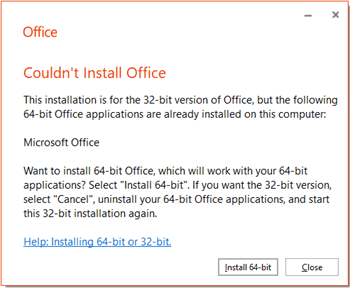In this article, we will describe some tips to help you avoid most Office setup or installation errors if you want to install and run multiple versions of Office on the same Windows 10 PC. This applies to Office 2019, Office 2016, Office 2013 and, unless stated otherwise, the following statements also apply to individual applications such as Visio and Project.
Keep in mind that even if you follow the recommendations below, you may still experience issues when using two versions of Office on the same PC. If you decide not to keep both versions and uninstall the earlier version, you may need to repair the remaining version of the Office suite to make sure that the file associations will work properly.
Install and use different versions of Office on the same computer
The advice / recommendations are as follows, but not limited to:
1) If you have a subscription or non-subscription version of Office 365, like Office Home and Small Business 2019, 2016 or 2013, in most cases, you can't run these versions together on the same computer.
There is one exception: if one of the two products is installed via MSI (which is common for volume licensed products), these two products can work side by side.
2) You can see a Stop, you have to wait to install Office Fault. This can happen if a standalone Office application (such as Word) is installed on your computer, but a newer version of the application is already included in the suite you are trying to install. In this case, the standalone version will be deleted.
However, if the standalone application is not part of the new Office suite you are trying to install, the standalone application will remain on the machine and the Office suite will be successfully installed.
3) Running multiple versions of Office on Windows 10 when Remote Desktop Services (RDS) is enabled is not supported.
On a computer on which Remote Desktop Service (RDS) is enabled, it is possible to install multiple versions of Office. However, this is not a supported Office configuration. To get the computer in a supported configuration, you can disable RDS or uninstall versions of Office, leaving only one version installed.
4) Install earlier versions of Office first. For example, install Office 2010 before installing Office 2019, Office 2016 or Office 2013. This also applies to other Office family products, such as Visio, Project or Access Runtime, as well as Language modules and proofreading tools. If you don't install Office in that order, you may need to repair later versions of Office afterwards.
5) Make sure all versions of Office are 32-bit or 64-bit. You cannot have a mixture of the two. You can see Office (64-bit or 32-bit) could not be installed error while trying to install.
To correct this error and go from 32 bit to 64 bit (or vice versa), you must do the following in this order.
- Uninstall Office
- Install the 32-bit or 64-bit version of Office.
I hope you find these tips useful!
